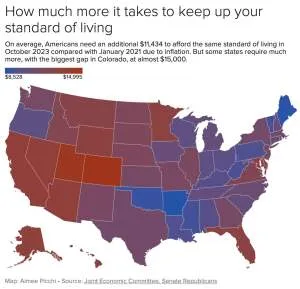(CBS News) The typical American household must spend an additional $11,434 annually just to maintain the same standard of living they enjoyed in January of 2021, right before inflation soared to 40-year highs, according to a recent analysis of government data.
Such figures underscore the financial squeeze many families continue to face even as the the rate of U.S. inflation recedes and the economy by many measures remains strong, with the jobless rate at a two-decade low.
Even so, many Americans say they aren’t feeling those gains, and this fall more people reported struggling financially than they did prior to the pandemic, according to CBS News polling. Inflation is the main reason Americans express pessimism about economy despite its bright points, which also include stronger wage gains in recent years.
“On the edge”
Average hourly pay for workers has increased robust 13.6% since January 2021, although that lags the 17% increase in inflation during the same period, according to government data. The main categories requiring heavier spending for consumers simply to tread water: food, transportation, housing and energy, which together account for almost 80 cents of every $1 in additional spending, according to the analysis from Republican members of the U.S. Senate Joint Economic Committee.
“Middle- and low-income Americans aren’t doing well enough — they are living fragilely on the edge,” said Gene Ludwig, chairman of the Ludwig Institute for Shared Economic Prosperity (LISEP), a think thank whose own analysis found that the income needed to cover the basics fell short by almost $14,000, on average, in 2022.
Where inflation bites hardest
Around the U.S., the state with the highest additional expenditures to afford the same standard of living compared with 2021 is Colorado, where a household must spend an extra $15,000 per year, the JEC analysis found. Residents in Arkansas, meanwhile, have to spend the least to maintain their standard of living, at about $8,500 on an annual basis.

The differences in costs are tied to local economic differences. For instance, typical housing in Colorado requires an additional $267 per month compared with January 2021, while other states saw much smaller increases, the analysis found.
Still, a higher cost of living doesn’t necessarily doom people to financial distress. Ludwig’s group recently found that some expensive cities offer the best quality of life for working-class Americans, largely because of the higher incomes that workers can earn in these cities.
Inflation takes a bigger bite out of lower-income households because by necessity they spend a bigger share of their income on basics than higher-income Americans. And until recently, lower- and middle-income workers’ wages weren’t keeping pace with the gains enjoyed by the nation’s top earners.






